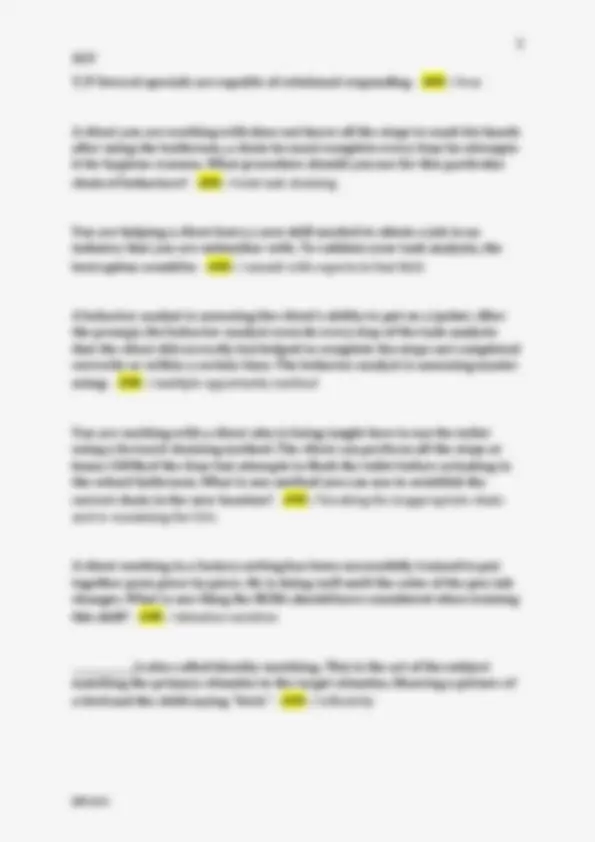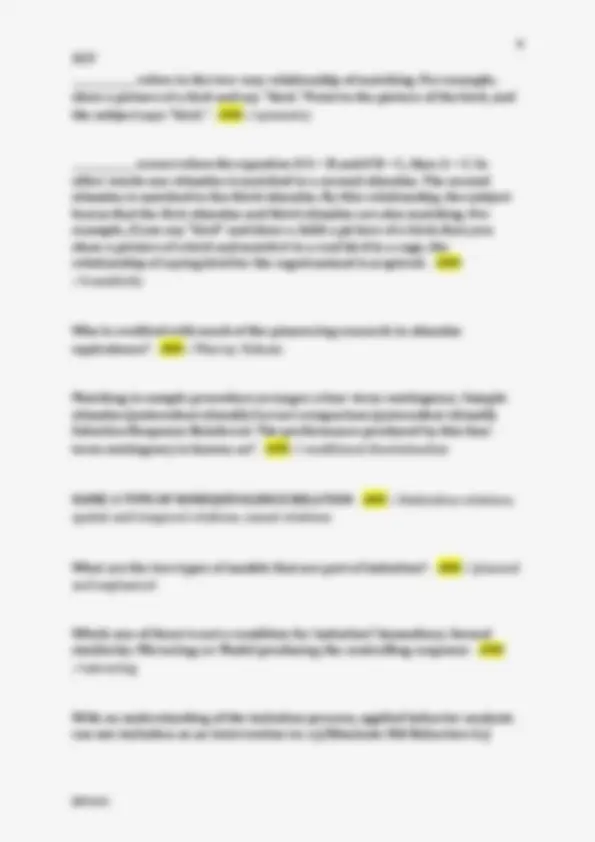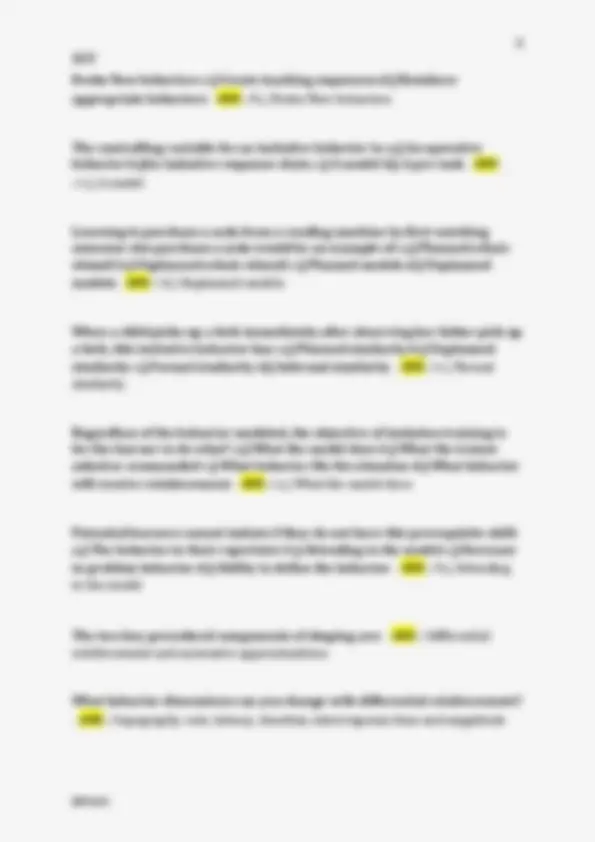





Study with the several resources on Docsity

Earn points by helping other students or get them with a premium plan


Prepare for your exams
Study with the several resources on Docsity

Earn points to download
Earn points by helping other students or get them with a premium plan
Community
Ask the community for help and clear up your study doubts
Discover the best universities in your country according to Docsity users
Free resources
Download our free guides on studying techniques, anxiety management strategies, and thesis advice from Docsity tutors
A series of questions and answers related to the concepts of stimulus equivalence, imitation, and task analysis. It covers key definitions, examples, and applications of these concepts in the context of applied behavior analysis. Useful for students studying behavior analysis and provides a comprehensive overview of these important topics.
Typology: Exams
1 / 6

This page cannot be seen from the preview
Don't miss anything!




_____________A type of stimulus to stimulus relation in which the learner, without any prior training or reinforcement for doing so, selects a comparison stimulus that is the same as the sample stimulus. This is a prerequisite to stimulus equivalence, generalized identity matching. - ANS ✓reflexivity _____________ refers to the two way relationship of matching. For example, show a picture of a bird and say "bird." Point to the picture of the bird, and the subject says "bird." After training of a relationship in one direction, the organism derives the untrained relationship in the reverse direction - ANS ✓symmetry When designing equivalence based instruction, what are the two types of design considerations you should begin with? - ANS ✓training considerations and testing considerations Match-to-sample confirms which concept of stimulus equivalence? - ANS ✓reflexivity Juda learns how to match a picture of a dog to an identical picture of a dog. Which concept of stimulus equivalence did we confirm? - ANS ✓reflexivity Micha is taught that the spoken word "cat" is a wonderful, fluffy animal with whiskers and a tail. Later, he is taught to write c-a-t when he hears the spoken word "cat". The next time he sees a wonderful cat he shouts "Cat! C- A-T!". Which concept of stimulus equivalence did we confirm? - ANS ✓transitivity
Julie was taught that the book on the shelf was called an "encyclopedia". When asked, "what is this?" she can say "encyclopedia." Which of the following would NOT have to be directly taught? a. how to break down syllables of the word encyclopedia b. how to spell encyclopedia c. How to get an encyclopedia off the shelf (among dictionaries and magazines) when asked to get one - ANS ✓How to get an encyclopedia off the shelf (among dictionaries and magazines) when asked to get one The encyclopedia question demonstrated which concept of stimulus equivalence? - ANS ✓symmetry Which of the following is an example of imitation? a. a child turns on the tv with the remote after school, which is typical of their routine. b. the RBT claps her hands and then physically prompts the child to clap their hands. c. The RBT says "Do this" and claps her hands. the child claps her hands d. A child throws leaves on a slide. His peer watches and picks up some leaves and throws it on the slide, too - ANS ✓d. A child throws leaves on a slide. His peer watches and picks up some leaves and throws it on the slide, too A child has now imitated at least 10 models. The behavior analyst wants to move on to a new goal. Which would you recommend the analyst select next? a. modeling hand washing for imitation b. modeling social skills for imitation c. modeling 2-step movements for imitation - ANS ✓modeling 2- step movements for imitation Which of the scenarios below is the best example of relational responding? a. when thirsty at a bbq, you find an alcoholic beverage in the cooler b. when thirsty at a bbq, you feel around for the coldest beer in the cooler, c. when thirsty at a bbq, you find your regular craft beer fav in the cooler - ANS ✓when thirsty at a bbq, you feel around for the coldest beer in the cooler You are asked to sort 3 triangles of different colors in the same size. In order to get it correct, what do you need? - ANS ✓contextual cue
_____________ refers to the two-way relationship of matching. For example, show a picture of a bird and say "bird." Point to the picture of the bird, and the subject says "bird." - ANS ✓symmetry _____________ occurs when the equation if A = B and if B = C, then A = C. In other words one stimulus is matched to a second stimulus. The second stimulus is matched to the third stimulus. By this relationship, the subject learns that the first stimulus and third stimulus are also matching. For example, if you say "bird" and show a child a picture of a bird, then you show a picture of a bird and match it to a real bird in a cage, the relationship of saying bird for the caged animal is acquired. - ANS ✓transitivity Who is credited with much of the pioneering research in stimulus equivalence? - ANS ✓Murray Sidman Matching to sample procedure arranges a four-term contingency. Sample stimulus (antecedent stimuli) Correct comparison (antecedent stimuli) Selection Response Reinforcer The performance produced by this four- term contingency is known as? - ANS ✓conditional discrimination NAME A TYPE OF NONEQUIVALENCE RELATION - ANS ✓distinction relations, spatial and temporal relations, causal relations What are the two types of models that are part of imitation? - ANS ✓planned and unplanned Which one of these is not a condition for imitation? Immediacy; formal similarity; Mirroring; or Model producing the controlling response - ANS ✓mirroring With an understanding of the imitation process, applied behavior analysts can use imitation as an intervention to: a.) Eliminate Old Behaviors b.)
Evoke New behaviors c.) Create teaching sequences d.) Reinforce appropriate behaviors - ANS ✓b.) Evoke New behaviors The controlling variable for an imitative behavior is: a.) An operative behavior b.)An imitative response chain c.) A model d.) A pre-task - ANS ✓c.) A model Learning to purchase a soda from a vending machine by first watching someone else purchase a soda would be an example of: a.) Planned echoic stimuli b.) Unplanned echoic stimuli c.) Planned models d.) Unplanned models - ANS ✓d.) Unplanned models When a child picks up a fork immediately after observing her father pick up a fork, this imitative behavior has: a.) Planned similarity b.) Unplanned similarity c.) Formal similarity d.) Informal similarity - ANS ✓c.) Formal similarity Regardless of the behavior modeled, the objective of imitation training is for the learner to do what? a.) What the model does b.) What the trainer asked or commanded c.) What behavior fits the situation d.) What behavior will receive reinforcement - ANS ✓a.) What the model does Potential learners cannot imitate if they do not have this prerequisite skill: a.) The behavior in their repertoire b.) Attending to the model c.) Decrease in problem behavior d.) Ability to define the behavior - ANS ✓b.) Attending to the model The two key procedural components of shaping are: - ANS ✓differential reinforcement and successive approximations What behavior dimensions can you change with differential reinforcement?